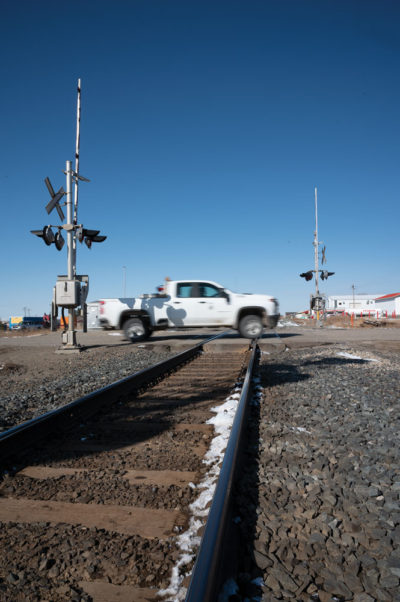Train whistles could stop in Carseland
By Sean Feagan, Local Journalism Initiative Reporter

Sean Feagan Photo
Carseland could become quieter, as Wheatland County is considering having Canadian Pacific Railway stop its trains from blowing whistles when approaching the railroad crossing there.
The single-track crossing is located at Barstow St. (Range Road 260), in the southeast of Carseland, just north of Highway 24. Trains must blow two long, one short and one long whistle starting a quarter mile away from at-grade crossings, as per Transport Canada’s rail operating rules.
There have been complaints made by several residents and business operators about the whistles bellowed by approaching trains, explained Wheatland County’s Division 3 Councillor Donna Biggar.
“It’s really hard to conduct business because there are a lot of trains going through and the whistle just pretty much stops whatever transaction or conversation,” said Biggar. “You get used to it, but as a business owner, I can see why they are wanting to do this.”
But where gates have been added to crossings, other communities have had railroad companies stop their trains from whistling when approaching, known as whistle cessation. For example, Strathcona County’s council passed a resolution to enact whistle cessation at five crossings in 2019.
Wheatland County contacted Canadian Pacific Railway (CPR) and Transport Canada to start the process of whistle cessation at the crossing. CPR’s Pete Bayerle and Garry Rosin presented their views on this proposed change at the March 23 county council meeting.
The crossing meets all the requirements for whistle cessation, said Bayerle, CPR senior manager of projects and public works for Western Canada. This is because it has flashing lights, bells and gates to protect sightlines and prevent cars from entering it when a train is on the track.
The crossing uses constant warning time equipment, added Rosin. This means the warning light system detects an approaching train, determines its speed and gives a more accurate warning time at the crossing. The goal is about 30 seconds of warning time at the crossing. There is an eight second delay after the lights start flashing before the gates start to lower. The gates will then be in a horizontal position five seconds before the train gets to the crossing.
But CPR is concerned about the safety of southbound traffic on Barstow St. at the crossing, because of a backtrack (or siding) located to the west. A train parked on this backtrack could obstruct the view to the west of an eastbound train approaching on the main line, said Bayerle.
There is concern that as the lights start to flash and the gates start to lower, someone might see the parked train and think it is why these systems are being activated. They might then enter the crossing where a train is coming down the main line at about 80 km/h. Without enough time for them to clear the tracks, they could be hit by the approaching train.
However, the parked trains on the backtrack are far from the crossing, and are likely not even seen by motorists, said Biggar.
“Every time I’ve seen a train off to the side, they’re quite a bit further west,” she said.
But the concern is CPR’s trains continue to get longer, said Bayerle. “It’s true that they’re parked a little further back right now, but that may not always be the case,” he said.
A safety study about whistle cessation at the crossing was prepared for Wheatland County by the Watt Consulting Group. At 50 km/h speed, the Transportation Association of Canada (TAC) recommends 65 metres for stopping sight distance. This is slightly below the distance between the crossing and Railway Avenue, to the north, equal to about 60 metres, according to the report.
But as vehicles travelling straight through the intersection with Railway Avenue are starting from a stop, they will not reach the 50 km/h speed limit before reaching the crossing. Still, the consultant recommended the speed limit on Barstow St. be decreased from 50 km/h to 40 km/h.
Wheatland County is planning a public engagement to get input from residents on the issue, including why CPR is concerned about removing the whistle at the crossing, said Biggar. If the public decides it is in their best interest to remove the whistle, county council can pass a whistle cessation resolution. CPR would then issue a bulletin to train crews to enact the change.
The decision will largely be up to Carseland residents, said Biggar. “Ultimately, the deciding factor will be the safety of the community – they have to feel it’s safe.”
